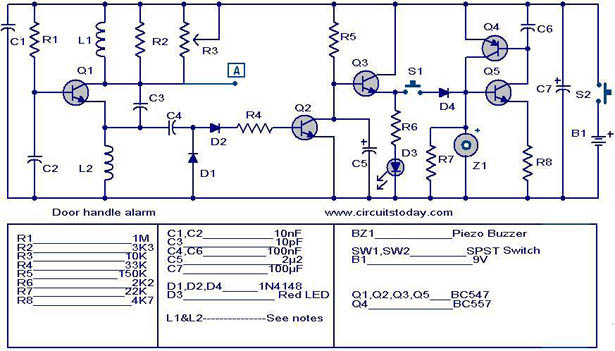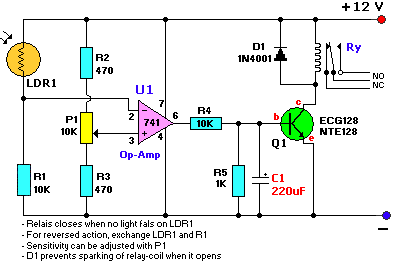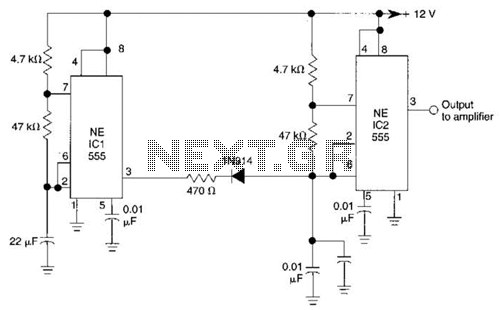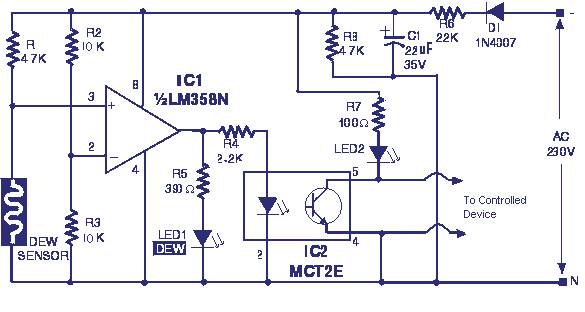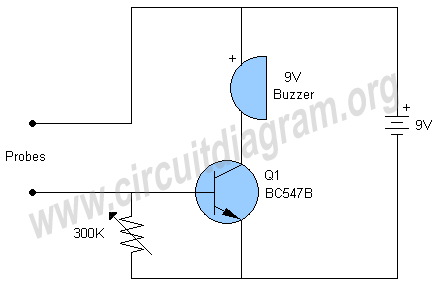
Water sensor alarm

This small water sensor alarm circuit produces a loud warning sound when a humidity sensor detects the presence of water. The circuit utilizes the low-power comparator LM1801 from National Semiconductor. The reference voltage for the integrated circuit is established using resistor R2. When the voltage at pin 4 of the LM1801 exceeds a predetermined threshold, the circuit is activated.
The water sensor alarm circuit is designed to provide an effective means of detecting water presence and alerting users through an audible alarm. The core component, the LM1801, serves as a voltage comparator, which continuously monitors the voltage level derived from the humidity sensor. The humidity sensor is typically a resistive or capacitive type that changes its resistance or capacitance based on moisture levels in the environment.
The reference voltage, set by resistor R2, is crucial for determining the sensitivity of the circuit. A lower resistance value will result in a lower reference voltage, making the circuit more sensitive to minor changes in humidity. Conversely, a higher resistance value will increase the reference voltage, requiring a more significant change in humidity to trigger the alarm.
When the humidity sensor detects water, it causes the voltage at pin 4 of the LM1801 to rise above the reference voltage. This condition activates the output pin, which can be connected to a piezoelectric buzzer or an alarm speaker. The alarm will sound loudly, alerting individuals in the vicinity to the presence of water, which could indicate a leak or flooding situation.
Additional components may include a power supply circuit to provide the necessary voltage to the LM1801 and the sensor, as well as bypass capacitors to stabilize the power supply and filter out noise. The circuit should be designed with appropriate safety measures, such as using components rated for the expected environmental conditions, including humidity and temperature variations.
Overall, this water sensor alarm circuit is a practical application of electronic components that provides a reliable warning system for water detection, ensuring timely intervention to prevent potential damage.This small water sensor alarm circuit makes a loud warning sound when a humidity sensor detects a quantity of water. This circuit assembly is an application of low power comparator LM1801 made by National Semiconductor.
The reference voltage for the integrated circuit is fixed with the help of R2.When pin 4 of the LM1801 voltage exceeds preset threshold, bec.. 🔗 External reference
The water sensor alarm circuit is designed to provide an effective means of detecting water presence and alerting users through an audible alarm. The core component, the LM1801, serves as a voltage comparator, which continuously monitors the voltage level derived from the humidity sensor. The humidity sensor is typically a resistive or capacitive type that changes its resistance or capacitance based on moisture levels in the environment.
The reference voltage, set by resistor R2, is crucial for determining the sensitivity of the circuit. A lower resistance value will result in a lower reference voltage, making the circuit more sensitive to minor changes in humidity. Conversely, a higher resistance value will increase the reference voltage, requiring a more significant change in humidity to trigger the alarm.
When the humidity sensor detects water, it causes the voltage at pin 4 of the LM1801 to rise above the reference voltage. This condition activates the output pin, which can be connected to a piezoelectric buzzer or an alarm speaker. The alarm will sound loudly, alerting individuals in the vicinity to the presence of water, which could indicate a leak or flooding situation.
Additional components may include a power supply circuit to provide the necessary voltage to the LM1801 and the sensor, as well as bypass capacitors to stabilize the power supply and filter out noise. The circuit should be designed with appropriate safety measures, such as using components rated for the expected environmental conditions, including humidity and temperature variations.
Overall, this water sensor alarm circuit is a practical application of electronic components that provides a reliable warning system for water detection, ensuring timely intervention to prevent potential damage.This small water sensor alarm circuit makes a loud warning sound when a humidity sensor detects a quantity of water. This circuit assembly is an application of low power comparator LM1801 made by National Semiconductor.
The reference voltage for the integrated circuit is fixed with the help of R2.When pin 4 of the LM1801 voltage exceeds preset threshold, bec.. 🔗 External reference
